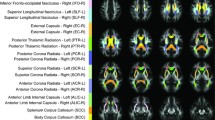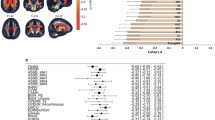Abstract
White matter abnormalities in schizophrenia have been revealed by many imaging techniques and analysis methods. One of the findings by diffusion tensor imaging is a decrease in fractional anisotropy (FA), which is an indicator of white matter integrity. On the other hand, elevation of metabolic rate in white matter was observed from positron emission tomography (PET) studies. In this report, we aim to compare the two structural and functional effects on the same subjects. Our comparison is based on the hypothesis that signal fluctuation in white matter is associated with white matter functional activity. We examined the variance of the signal in resting state fMRI and found significant differences between individuals with schizophrenia and non-psychiatric controls specifically in white matter tissue. Controls showed higher temporal signal-to-noise ratios clustered in regions including temporal, frontal, and parietal lobes, cerebellum, corpus callosum, superior longitudinal fasciculus, and other major white matter tracts. These regions with higher temporal signal-to-noise ratio agree well with those showing higher metabolic activity reported by studies using PET. The results suggest that individuals with schizophrenia tend to have higher functional activity in white matter in certain brain regions relative to healthy controls. Despite some overlaps, the distinct regions for physiological noise are different from those for FA derived from diffusion tensor imaging, and therefore provide a unique angle to explore potential mechanisms to white matter abnormality.





Similar content being viewed by others
References
Andreasen, N., Ehrhardt, J., Swayze, V., Tyrrell, G., Cohen, G., Ku, J. S., & Arndt, S. (1991). T1 and T2 relaxation times in schizophrenia as measured with magnetic resonance imaging. Schizophrenia Research, 5, 223–232.
Beaulieu, C. (2002). The basis of anisotropic water diffusion in the nervous system - a technical review. NMR in Biomedicine, 15, 435–455.
Benes, F. (2000). Emerging principles of altered neural circuitry in schizophrenia. Brain Research. Brain Research Reviews, 31, 251–269.
Buchsbaum, M., Tang, C., Peled, S., Gudbjartsson, H., Lu, D., Hazlett, E., Downhill, J., Haznedar, M., Fallon, J., & Atlas, S. (1998). MRI white matter diffusion anisotropy and PET metabolic rate in schizophrenia. Neuroreport, 9, 425–430.
Buchsbaum, M., Buchsbaum, B., Hazlett, E., Haznedar, M., Newmark, R., Tang, C., & Hof, P. (2007). Relative glucose metabolic rate higher in white matter in patients with schizophrenia. The American Journal of Psychiatry, 164, 1072–1081.
Camchong, J., MacDonald, A., III, Bell, C., Mueller, B., & Lim, K. (2011). Altered functional and anatomical connectivity in schizophrenia. Schizophrenia Bulletin, 37, 640–650.
Davis, K., Stewart, D., Friedman, J., Buchsbaum, M., Harvey, P., Hof, P., Buxbaum, J., & Haroutunian, V. (2003). White matter changes in schizophrenia: evidence for myelin-related dysfunction. Archives of General Psychiatry, 60, 443–456.
Ding, Z., Newton, A., Xu, R., Anderson, A., Morgan, V., & Gore, J. (2013). Spatio-temporal correlation tensors reveal functional structure in human brain. PLoS ONE, 8, e82107.
Du, F., Cooper, A., Cohen, B., Renshaw, P., & Öngür, D. (2012). Water and metabolite transverse T2 relaxation time abnormalities in the white matter in schizophrenia. Schizophrenia Research, 137, 241–245.
Du, F., Cooper, A., Thida, T., Shinn, A., Cohen, B., & Ongür, D. (2013). Myelin and axon abnormalities in schizophrenia measured with magnetic resonance imaging techniques. Biological Psychiatry, 74, 451–457.
First, M. B., Spitzer, R. L., Miriam, G., & Williams, J. B.W. (2002). Structured clinical interview for DSM-IV-TR axis i disorders, research version, patient edition with psychotic screen (SCID-I/P W/ PSY SCREEN). New York: Biometrics Research, New York State Psychiatric Institute.
Gawryluk, J., Mazerolle, E., & D’Arcy, R. (2014). Does functional MRI detect activation in white matter? A review of emerging evidence, issues, and future directions. Frontiers in Neuroscience, 8, 239.
Honea, R., Crow, T., Passingham, D., & Mackay, C. (2005). Regional deficits in brain volume in schizophrenia: a meta-analysis of voxel-based morphometry studies. The American Journal of Psychiatry, 162, 2233–2245.
Hua, K., Zhang, J., Wakana, S., Jiang, H., Li, X., Reich, D., Calabresi, P., Pekar, J., van Zijl, P., & Mori, S. (2008). Tract probability maps in stereotaxic spaces: analysis of white matter anatomy and tract-specific quantification. NeuroImage, 39, 336–347.
Innocenti, G., Ansermet, F., & Parnas, J. (2003). Schizophrenia, neurodevelopment and corpus callosum. Molecular Psychiatry, 8, 261–274.
Karlsgodt, K., Niendam, T., Bearden, C., & Cannon, T. (2009). White matter integrity and prediction of social and role functioning in subjects at ultra-high risk for psychosis. Biological Psychiatry, 66, 562–569.
Kim, S., Rostrup, E., Larsson, H., Ogawa, S., & Paulson, O. (1999). Determination of relative CMRO2 from CBF and BOLD changes: significant increase of oxygen consumption rate during visual stimulation. Magnetic Resonance in Medicine, 41, 1152–1161.
Kruger, G., & Glover, G. H. (2001). Physiological noise in oxygenation-sensitive magnetic resonance imaging. Magnetic Resonance in Medicine, 46, 631–637.
Kubicki, M., McCarley, R., Westin, C., Park, H., Maier, S., Kikinis, R., Jolesz, F., & Shenton, M. (2007). A review of diffusion tensor imaging studies in schizophrenia. Journal of Psychiatric Research, 41, 15–30.
Lee, S., Kubicki, M., Asami, T., Seidman, L., Goldstein, J., Mesholam-Gately, R., McCarley, R., & Shenton, M. (2013). Extensive white matter abnormalities in patients with first-episode schizophrenia: a diffusion tensor imaging (DTI) study. Schizophrenia Research, 143, 231–238.
Lund, T. E., Madsen, K. H., Sidaros, K., Luo, W., & Nichols, T. E. (2006). Non-white noise in fMRI: does modelling have an impact. NeuroImage, 29, 54–66.
Lynall, M., Bassett, D., Kerwin, R., McKenna, P., Kitzbichler, M., Muller, U., & Bullmore, E. (2010). Functional connectivity and brain networks in schizophrenia. The Journal of Neuroscience, 30, 9477–9487.
Ogawa, S., Lee, T., Kay, A., & Tank, D. (1990). Brain magnetic resonance imaging with contrast dependent on blood oxygenation. Proceedings of the National Academy of Sciences, 87, 9869–9872.
Pantano, P., Baron, J., Lebrun-Grandié, P., Duquesnoy, N., Bousser, M., & Comar, D. (1984). Regional cerebral blood flow and oxygen consumption in human aging. Stroke, 15, 635–641.
Pfefferbaum, A., Sullivan, E., Hedehus, M., Moseley, M., & Lim, K. (1999). Brain gray and white matter transverse relaxation time in schizophrenia. Psychiatry Research, 91, 93–100.
Pinkham, A., Loughead, J., Ruparel, K., Wu, W., Overton, E., Gur, R., & Gur, R. (2011). Resting quantitative cerebral blood flow in schizophrenia measured by pulsed arterial spin labeling perfusion MRI. Psychiatry Research, 194, 64–72.
Raichle, M., & Gusnard, D. (2002). Appraising the brain’s energy budget. Proceedings of the National Academy of Sciences, 99, 10237–10239.
Ren, W., Lui, S., Deng, W., Li, F., Li, M., Huang, X., Wang, Y., Li, T., Sweeney, J., & Gong, Q. (2013). Anatomical and functional brain abnormalities in drug-naive first-episode schizophrenia. The American Journal of Psychiatry, 170, 1308–1316.
Ripke, S., O’Dushlaine, C., Chambert, K., et al. (2013). Genome-wide association analysis identifies 13 new risk loci for schizophrenia. Nature Genetics, 45, 1150–1159.
Roemer, P., Edelstein, W., Hayes, C., Souza, S., & Mueller, O. (1990). The NMR phased-array. Magnetic Resonance in Medicine, 16, 192–225.
Sachdev, P., & Brodaty, H. (1999). Quantitative study of signal hyperintensities on T2-weighted magnetic resonance imaging in late-onset schizophrenia. The American Journal of Psychiatry, 156, 1958–1967.
Shenton, M., Dickey, C., Frumin, M., & McCarley, R. (2001). A review of MRI findings in schizophrenia. Schizophrenia Research, 49, 1–52.
Spencer, K., Nestor, P., Niznikiewicz, M., Salisbury, D., Shenton, M., & McCarley, R. (2003). Abnormal neural synchrony in schizophrenia. The Journal of Neuroscience, 23, 7407–7411.
Triantafyllou, C., Hoge, R., Krueger, G., Wiggins, C., Potthast, A., Wiggins, G., & Wald, L. (2005). Comparison of physiological noise at 1.5 T, 3 T and 7 T and optimization of fMRI acquisition parameters. NeuroImage, 26, 243–250.
Triantafyllou, C., Hoge, R., & Wald, L. (2006). Effect of spatial smoothing on physiological noise in high-resolution fMRI. NeuroImage, 32, 551–557.
Uhlhaas, P., & Singer, W. (2010). Abnormal neural oscillations and synchrony in schizophrenia. Nature Reviews Neuroscience, 11, 100–113.
Van Dijk, K., Sabuncu, M., & Buckner, R. (2012). The influence of head motion on intrinsic functional connectivity MRI. NeuroImage, 59, 431–438.
Wang, H., Menezes, N., Zhu, M., Ay, H., Koroshetz, W., Aronen, H., Karonen, J., Liu, Y., Nuutinen, J., Wald, L., & Sorensen, A. (2008). Physiological noise in MR images: an indicator of the tissue response to ischemia? Journal of Magnetic Resonance Imaging, 27, 866–871.
White, T., Magnotta, V., Bockholt, H., Williams, S., Wallace, S., Ehrlich, S., Mueller, B., Ho, B., Jung, R., Clark, V., Lauriello, J., Bustillo, J., Schulz, S., Gollub, R., Andreasen, N., Calhoun, V., & Lim, K. (2011). Global white matter abnormalities in schizophrenia: a multisite diffusion tensor imaging study. Schizophrenia Bulletin, 37, 222–232.
Acknowledgments
This work was supported by the National Institute of Mental Health (R01 MH074983 and R01 2MH074983 to WPH).
Conflicts of interest
Hu Cheng, Sharlene D. Newman, Jerillyn S. Kent, Amanda Bolbecker, Mallory J. Klaunig, Brian F. O'Donnell, Aina Puce, and William P. Hetrick declare that they have no conflicts of interest.
Informed consent
All procedures followed were in accordance with the ethical standards of the responsible committee on human experimentation (institutional and national) and with the Helsinki Declaration of 1975, and the applicable revisions at the time of the investigation. Informed consent was obtained from all patients for being included in the study.
Author information
Authors and Affiliations
Corresponding author
Rights and permissions
About this article
Cite this article
Cheng, H., Newman, S.D., Kent, J.S. et al. White matter abnormalities of microstructure and physiological noise in schizophrenia. Brain Imaging and Behavior 9, 868–877 (2015). https://doi.org/10.1007/s11682-014-9349-1
Published:
Issue Date:
DOI: https://doi.org/10.1007/s11682-014-9349-1




